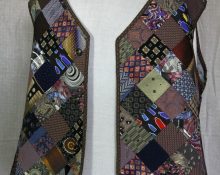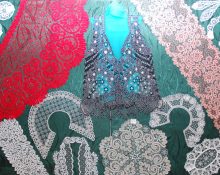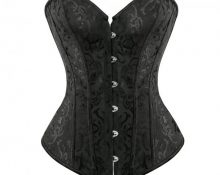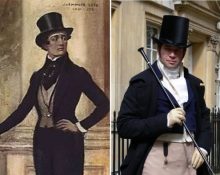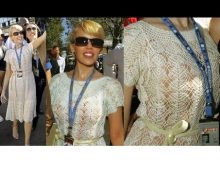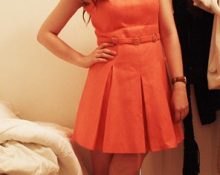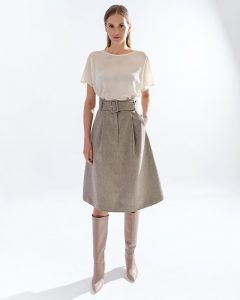
creativecommons.org
Pintucked skirts are wonderful for their versatility. This is the same style that will suit almost any type of figure, and varying the number of tucks and the width of the folds can significantly change the appearance of the product. In this article we will tell you the history of the pintucked skirt and what accessories it goes best with. At the end of the article you will find photographs with the most successful ideas for 2021 combining trends and a classic skirt with pintucks.
History of skirts
The first prototypes of skirts appeared in the times of ancient people and resembled loincloths. They were made from animal skins or palm leaves. Gradually, with the development of weaving, skirts began to be made from fabrics and wool. It is curious that initially the skirt was considered rather part of a man’s wardrobe, but today skirts are worn exclusively by women (and the Scots, when wearing their national costume).Despite the fact that in the United States and Europe over the past few years there have been men who periodically wear skirts and dresses, believing that clothing has no gender, yet for most of society the skirt remains an exclusively feminine outfit.
The first images of fabric skirts date back to the 3rd millennium BC. During excavations in the territory between the Tigris and Euphrates, images were discovered confirming that the inhabitants of Mesopotamia wore multi-tiered products, in their design reminiscent of modern skirts, decorated with fringes at the bottom. Products similar to skirts were also found in Ancient Egypt: the Egyptians used a large piece of fabric, called shenti, wrapping it several times around the waist and securing it with a cord at the top. The length of the fabric directly depended on the status of the owner of the shenti. Thus, noble men used more layers to emphasize their position. Skhenti also differed in materials: bleached linen was worn only by pharaohs and members of their family, nobles and priests could wear skhenti in relatively bright colors (red, saffron, and during mourning - blue), artisans wore clothes made of fabric in natural muted shades, and slaves more often they were limited to leather loincloths. Usually skhenti were decorated with colored belts. Just as with Mesopotamia, in Ancient Egypt skirts were considered an item of men's clothing. The Persians (the ancestors of the modern inhabitants of Iraq, Pakistan and Iraq) adopted this clothing from the Egyptians, transforming the skhenti into an analogue of a flared skirt. In such an outfit it was not hot and even relatively comfortable to ride (for convenience, the riders grabbed the skirt with a leather belt between their legs).
For the first time, a skirt as a separate element of clothing that was not connected to a bodice became part of a woman’s wardrobe only in the 15th century in Italy. By that time, they were worn by women of all walks of life. This moment became the starting point for the history of skirts, since after it this type of clothing lost its masculinity. Skirts began to be layered and provided with supporting frames. It seemed that if men's skirts were intended to simplify life for representatives of the stronger sex, then the women's version of skirts, on the contrary, sought to fetter their mistresses. Corsets began to be attached to skirts, and when Spanish ladies began to dictate fashion in the 16th century, special linings and frames began to be put under skirts to make them even fuller and heavier. The most desperate fashionistas wore up to 50 kilograms of clothing. In the 17th century, the British introduced the fashion for whalebone frames, so those who could afford them had the opportunity to abandon heavy metal frames. Whalebone hoops were replaced by crinoline and pads to add volume. The so-called bustle dresses actually consisted of several separate parts: a corset, a skirt and a bustle with a bolster.
Fashion for skirts with tucks
By the early 20th century, women's clothing had become more wearable, thanks in part to the contributions of designers Coco Chanel and Paul Poiret, who gave fashionistas the long-awaited trend for comfortable clothing. At the same time, thanks to the creator of the little black dress, the first versions of modern skirts with pintucks appeared. These were rather strict silhouettes of the 1920s, most often slightly lowered at the bottom, and the width of the hips was emphasized by pleats, adding volume. In the 1940s, Christian Dior introduced the world to the pencil skirt, adding a high waist and pintucks to his model.
A real revolution in the history of skirts occurred in the second half of the twentieth century, so in the 1960s the length of the product could vary up to 50-40 centimeters. Such a dramatic change occurred thanks to the daring Mary Quant, who created the first miniskirt model. And although evil tongues said that the skirt was so long due to a lack of fabric, it is safe to say that Quant took such a bold step not because of saving materials. Since then, the length of the skirt and its cut have constantly changed, rising above the knees and falling below the ankle. The pintucked skirt is considered one of the classic models and still regularly appears on the runways, changing its colors depending on trends and Pantone.
How to choose the right pleated skirt
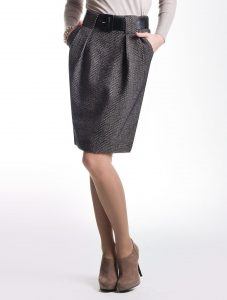
creativecommons.org
It is best to choose skirts with pintucks from plain fabrics in calm shades or buy them as a set with a jacket if you still decide to go with a non-standard color. Pintucked skirts are considered variations of the classic skirt, so adding prints or bold accessories can overwhelm the look. It is best to choose skirts made from natural fabrics that are less electrified and pleasant to the body: high-quality cotton, wool, linen. Girls with large breasts and a defined waist should especially take a closer look at skirts with pintucks. This way the product will highlight the fashionable hourglass silhouette.
What goes best with pintucked skirts?
Pintucked skirts look best with stilettos, pumps or low-heeled sandals, although modern fashion allows you to wear this classic model, including with sports sneakers.For tops, if you want to accentuate a pintucked skirt, consider turtlenecks, silk tops, or minimalist blouses. The most advantageous option for a skirt with tucks is considered to be a skirt with bow stitching, which delicately and unobtrusively emphasizes the hip line.


 0
0